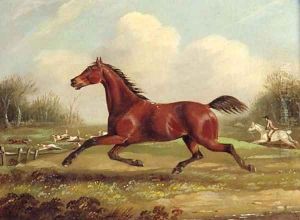Charles Dean Wolstenholme Paintings
Charles Dean Wolstenholme was an English painter born in 1830 in Sheffield, England. He is best known for his works depicting animals, particularly sporting and hunting scenes. His father, Dean Wolstenholme the Elder (1757–1837), was also a notable artist, and young Charles was heavily influenced by his father's work and reputation in the field of animal painting.
Wolstenholme received his education in art largely through the influence of his father, developing a keen interest in capturing the essence of rural life and the animals within it. Throughout his career, he maintained a focus on the accuracy and detail of the animals he painted, which appealed to the sporting gentry of the time and earned him a dedicated following.
His work was characteristic of the Victorian era, with an emphasis on the romanticized depiction of the English countryside and its associated leisure activities. Wolstenholme exhibited his paintings in various prestigious venues, including the Royal Academy and the British Institution.
Despite the popularity of his work during his lifetime, Charles Dean Wolstenholme did not achieve the same lasting fame as some of his contemporaries. Nevertheless, his paintings are still appreciated by collectors of English animal and sporting art. He continued to paint throughout his life, contributing to the tradition of animal painting in Britain.
Wolstenholme passed away in 1926, leaving behind a legacy of work that continues to be studied and enjoyed by those with an interest in Victorian art and the portrayal of animals in art history. His paintings are now considered a window into the past, offering insights into the cultural and social dynamics of rural England during the 19th century.
